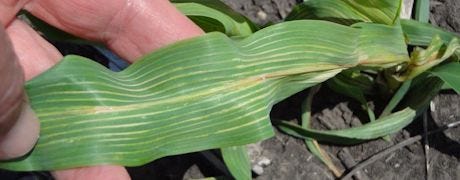June 5, 2014

Iowa State University Extension weed management specialists Mike Owen and Bob Hartzler have received some calls from farmers and crop consultants this spring regarding suspected fomesafen carryover injury to corn. Fomesafen is a group 14 herbicide (PPO inhibitor), and it is the active ingredient in Reflex, Flexstar, Prefix, Marvel and other products that are applied to control weeds in soybeans. Under certain conditions, it can carry over in the soil and cause herbicide injury symptoms on corn planted in that field the following year.

CARRYOVER SYMPTOMS: Fomesafen carryover injury symptoms typically only affect two or three leaves on corn but this situation can cause stand loss, so it needs to be closely monitored, say ISU weed management specialists.
This carryover is typically associated with applications made after late June and/or when the season turns dry following application, explains Hartzler. Labels of most products containing fomesafen specify a 10-month rotation interval for planting corn.
The primary symptom of fomesafen injury is striped leaves due to chlorotic or necrotic veins on the leaves. Other factors can cause striping on leaves, but fomesafen is unique in that the veins are affected rather than interveinal tissue. Some of the leaves may fold over midway due to loss of integrity of the leaf midvein.
Frequently only two or three leaves are affected and injured plants recover quickly. However, at times there can be stand loss and the only way to determine the potential impact is to determine the percentage of plants affected and closely monitor the rate of recovery, says Hartzler.
Be careful which "rescue" herbicide you choose for beans
The spread of glyphosate resistant waterhemp has led to an increase in 'rescue' applications with group 14 herbicides such as fomesafen, lactofen (Cobra, etc.) and acifluorfen (UltraBlazer, etc.). Of these products, only fomesafen poses a threat to rotational corn. A switch to alternative herbicides later in the season can avoid this risk. "However, keep in mind that late applications of group 14 herbicides usually are ineffective against the large waterhemp present at these times," says Hartzler. "Ideally, develop integrated strategies that minimize the need for mid-season rescue operations."
Virgil Schmitt, ISU Extension field agronomist in southeast Iowa, says the carryover is caused by fomesafen, the active ingredient in Flexstar and Reflex soybean herbicides as well as several "generics," such as Battlestar, Dawn, Rhythm, Ringside, Rumble, Shafen, Topgun, etc. Fomesafen is also present in combination with other active ingredients in several products, such as Flexstar GT, Flexstar GT 3.5, Marvel, Prefix and Statement. Fomesafen was applied to many soybean fields in 2013.
~~~PAGE_BREAK_HERE~~~
Fomesafen was applied on many soybean fields in 2013
"The Flexstar label states that corn should not be planted for 10 months after Flexstar application, and in many fields this spring, corn was planted less than 10 months after the fomesafen application," says Schmitt. "In addition, the dry weather in 2013 slowed down the normal rate of chemical breakdown. The cold winter may also have reduced the amount of breakdown that would normally occur."
Corn injured by fomesafen carryover will exhibit veinal chlorosis. The veins will be chlorotic while the area of the leaf between the veins will remain green. Some people are getting this symptom confused with sulfur deficiency, notes Schmitt. Sulfur deficiency is the exact opposite, with the veins remaining green and the interveinal material becoming chlorotic or yellow. This is often seen in low organic matter areas without a history of animal manure and in instances where rapid top growth outpaces root development and the ability to move sulfur into the plant rapidly enough.
"Corn normally recovers quickly from fomesafen injury," says Schmitt. "I'm not aware of any instance where yield loss due to this injury has been documented."
Waterhemp is much easier to control before its 4 inches tall
"I've noticed waterhemp and other weeds coming in several of the fields I've been in," says Mark Johnson, an ISU Extension field agronomist in central Iowa. "It's best to spray for waterhemp soon, as it is much easier to control before it is 4 inches tall. Also, the later your spray, which is true for many herbicides, such as Flexstar soybean herbicide and others, the more chance of carryover problems when the field is planted to corn next year. With later soybean planting this year, you need to keep the 10 month crop rotation interval in mind for next year's corn."
Another weed control issue: the potential for interactions between post herbicides and soil insecticides exists. Check both labels: insecticide and herbicide. The biggest concern is with Counter insecticide, says Johnson. "The same plant enzyme used to metabolize the insecticide is used to metabolize some herbicides, in this case ALS herbicides. Using both pesticides in the same crop year can overload the plant metabolic processes."
You May Also Like




